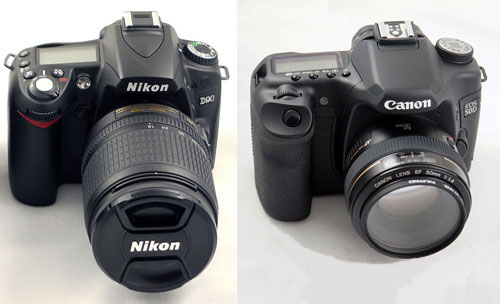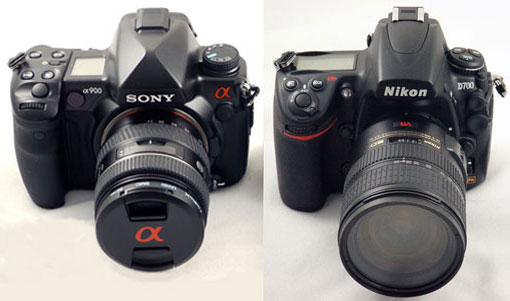Digital Cameras for the Holidays
by Wesley Fink on November 27, 2008 12:00 AM EST- Posted in
- Digital Camera
2007 turned out to be the year of the Digital SLR, just as many predicted. Industry shipments confirm the huge growth in Digital SLR sales in 2007, and that growth continued through most of 2008. Many believed the slowing economy would have no impact at all on the growth of DSLR sales; however, the last couple of months have seen lower growth than expected.
That news means there will be many bargains in current Digital Camera models over this holiday season. Year-end is always a time of bargains, but they are usually last year's models. This year you will likely see sale prices on the latest and greatest. That's good news if you're in the market for a new digital camera this year.
There are also bargains galore on low-end point-and-shoot digital cameras. As prices have fallen on DSLR cameras it has pushed the P&S prices even lower. For the first time we've found a couple of point-and-shoot cameras we can easily recommend that are selling for around $100. You will also find recommendations for good values in the Superzoom category. Bigger sensors (larger size, not higher resolution) are coming to the P&S market and that development is already having an impact.

We have also been enjoying our time with the new micro 4/3 Panasonic G1. This interchangeable lens digital is not an SLR, but it is likely to become the poster child for what's coming in the midrange "DSLR" and Point-and-Shoot space. Very few things are truly revolutionary in electronics, let alone the slower paced digital camera market. The Panasonic G1 is truly revolutionary, as you will see in our recommendations in entry and midrange interchangeable lens cameras.

With the introduction of the Nikon D90 and Canon 50D, the advanced amateur or "prosumer" market is finally complete for a few months. This recommendation always generates the most comments as buyers loyal to one camp or another question our picks for the buyer's guide. With so many competent DSLRs in this segment this year, the choice was difficult.

With the three biggest players all with full-frame (35mm size sensor) models at the top, it should be crystal clear that our prediction last year that full-frame become would become the camera of choice in the pro market has certainly come true. It happened even faster that we thought, and there are now 5 full-frame DSLRs with more on the way. Three very different models now compete at $3000 or less in a market first carved out by Canon. It's fair to ask if anyone can price a full-frame DSLR at $8000 any more?
If you are shopping for a digital camera but you're not really a photo hobbyist, you might want to start with our overview of digital photography in Digital Photography from 20,000 Feet. If you want to delve a little deeper you really need to know more about the digital sensor, an analog device that is the heart of any digital camera. Take a look at our two part series on the Digital Sensor in The Digital Sensor: A Guide to Understanding Digital Cameras and The Digital Sensor: Part 2.










41 Comments
View All Comments
Wesley Fink - Friday, November 28, 2008 - link
We;ve added mention of the Pentax K20D as a great value at $750 to $800 in the Prosumer category. It is not, however, without its probelms, as is true of any camera, and the price has dropped from $1295 to $750 in pretty short order. Its an outstnding value if it fits your needs and the way you shoot.ubiloo - Friday, November 28, 2008 - link
Sorry, I meant 'for at least €100 less'computerfarmer - Thursday, November 27, 2008 - link
If I were to choose.......from this article.Point and shoot:
Panasonic Lumix DMC-L8 for quality, Canon Powershot A590 IS best for the money.
Super Zoom:
Panasonic Lumix LMC-TZ5
Entry Interchangeable Lens:
Canon XSi or XS and Panasonic G1
At this level, all make decent products....hard to choose.
Prosumer:
Nikon D90 or Canon 50D ....hard to choose.
Full-Frame:
Nikon D700 or Canon 5D Mark II
I am about to enter the "Entry Interchangeable Lens" category, perhaps in March or April. I have gone from point and shoot to superzoom. Panisonic FZ8 is camera I have now. It is so much better than the point and shoot. But the cost to go up to the next level is quite substantial. With a kit lens, I will not get the zoom I am accustomed too. The macro part I am unsure of. Then there is the flash. The number one reason for upgrading is the quality of photograph. The question I have is, if I wanted to print 13x19 inch photos, what camera and lens would do the best job for, Portraits, Birds, Indoors....
Example: If I purchased a Canon Rebel XSi; what else would I need to get the most out of this camera(general use). I am thinking the camera with the kit lens, plus a 200mm zoom lens, a macro lens, a flash(wireless would be nice), a good tripod. how much would this cost me?
This article gave a good overall view.....Thank You
strikeback03 - Monday, December 1, 2008 - link
Unless the birds are very tame, 200mm isn't very long. A friend of mine has the XTi with 18-55IS/55-250IS combo though and is very happy with them for general use. The 55-250IS is not that expensive, B&H has a kit with XSi/18-55IS/55-250IS for $708. The 100/2.8 Macro is a good macro lens and also very usable for tighter portraits, runs around $450. No Canon bodies offer wireless flash control in-body, so the flash itself ranges from $200-400 depending on power and features, and if you want wireless you either need remote triggers and external metering, or a ST-E2 wireless transmitter. Tripods are highly dependent on what you want and need, but guessing at least $100 is pretty safe.Note that for some items (lenses, flash) you can sometimes find third-party alternatives which work as well for your needs for less money.
haplo602 - Friday, November 28, 2008 - link
have a look on ebay ...I don't know the canon line of lenses, but something similar to the AF-S DX NIKKOR 18-105mm f/3.5-5.6G ED VR will make a good all-around starter lens.
Maxington - Thursday, November 27, 2008 - link
The G1 is revolutionary alright, its a camera that does away with the mirror box and optical viewfinder, without actually being any smaller than standard DSLRs!Why is this article have such a huge positive bias towards it? It should be applauded for actually trying, but totally dismissed until, like the rest of the 4/3rds range, it actually delivers on making a camera small. How you can recommend it whatsoever is beyond me.
Hell, Pentax have a far smaller setup, with the K2000/Km body, and their pancake lens range. And a better performing sensor with a bigger lens range to boot.
Speaking of Pentax, why were no Pentax cameras recommended? They are far better value for money than Nikon/Canon, though Sony camera bodies are probably the best value, pity their lenses are ridiculously priced.
Wesley Fink - Friday, November 28, 2008 - link
The G1 is a great deal smaller overall than any DSLR we have tested, but it also has many other features going for it, like the superb 3 inch tilt-and swivel hi-res LCD and the first EVF we could actually live with. It also breaks new ground in Live View AF.We agree the Pentax K20D is a great value at $750 to $800, and mention of the K20D has been added. It should also be mentioned that the price of the K20D has declined from $1295 to $750 in pretty short time. The pro-type sealing and 14.6 megapixel sensor are top of the class, but the high ISO noise, inconsistent color at high ISO, slow AF, and slow continuous frame-rates detract from the top-notch features.
gaston1 - Friday, November 28, 2008 - link
Thank you for adding K20D to the list. I agree about the AF being slower than the competition. High ISO noise, not really, I'd say it's in line with other APS-C cameras in its range, although Pentax has taken a different approach, producing grainier pictures at high ISO but preserving much more detail than the others (and can be cleaned very easily through software if one chooses to). ISO 1600 is very useable, 3200 is sort of equivalent to the K10D's 1600, not that clean but useful when needed, and the 6400 is not that useable, in my opinion. We must also not forget that most reviews (comparing jpegs) will have Pentax tested on its default setting with noise reduction off while it kicks in by default on other cameras once you start using higher ISO settings. Canon's ISO 12800 hardly contains any detail at all, and in my opinion is just there for marketing purposes.As far as value goes, Pentax shines when you start considering lenses. I strongly considered going for the Nikon D700 or even waiting for the Canon 5D mkII, both great cameras for low light (or landscape) photography. But after researching the lenses that I would need, the system price was quickly stretching far beyond my amateur's budget (although still a bargain if you're a pro and need the features). I even briefly considered Sony's A900 but had a similar issue with the cost of lenses.
strikeback03 - Monday, December 1, 2008 - link
I don't really see the advantage in Pentax lens prices that you mention. Seems like they have dropped some, as a year ago I initially recommended a K10D with 16-50 2.8 to a friend, expecting the 16-50 to be around $500. I was shocked to see it was around $900 at the time. At least now it is more reasonable. Checking other similar lenses they seem to be mostly in line with Canon/Nikon, with some deals (50/1.4 for $200) and some more expensive (the 77/1.8 vs 85/1.8 from others).Maxington - Friday, November 28, 2008 - link
Echoing what gaston1 said, thanks for adding the K20D to the list.Also echoing the high iso comment, Pentax has higher noise due to it retaining detail and not smearing it away like Nikon/Canon do. I'd rather keep the detail and post-process it later, with much better tools, than let the camera do it.
http://www.dpreview.com/reviews/pentaxk20d/page18....">http://www.dpreview.com/reviews/pentaxk20d/page18....
Look at the mush the others turn into.
I'm still not convinced the minor size drop the Panasonic G1 has makes it worthwhile. (It's about half a cm shorter than the Pentax Km, and about 2cm thinner) It's not small enough to drop into "pocket" range, especially with the lack of pancake lenses, thus any size benefit it has is pretty much pointless. It's still a DSLR to carry. When they get it down to being like a rangefinder, then it'll be worth looking at.
I do like the back lcd and the slick contrast af though.